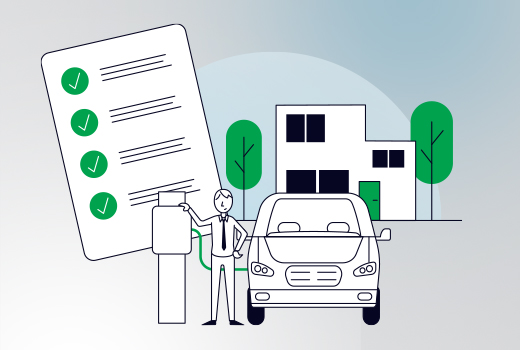Charging PV surplus
Green energy for your electric car
Connecting your charging station to your PV system

Charging PV surplus
Green energy for your electric car
Connecting your charging station to your PV system

Cost- and energy-efficient charging with solar power
The rise in energy costs makes PV systems even more interesting for homeowners. However, due to the current high electricity generation costs, it is advisable to consume as much of the self-generated electricity as possible. The so-called electricity generation costs are the costs incurred for converting a form of energy into electricity. As an e-driver, you have a lot of potential here. Charging your electric car at home using your own charging station is generally particularly convenient. If you have a solar system on your roof, you can also use a charging solution designed for this purpose to charge your electric car with self-generated electricity, making it particularly sustainable, cost-effective and energy-efficient.
Quick Facts Solar Charging
Optimizing PV self-consumption
Save money
Charge green electricity and contribute to greater sustainability
A smart wallbox for your smart home
Conveniently set charging mode with myWallbox app
Intelligent energy and load management system for your wallbox
Product Recommendation for Charging Solar Power

Wallbox ABL Pulsar Solar Bundle
The Wallbox ABL Pulsar Solar Bundle includes the Wallbox ABL Pulsar and the Energy Meter Pulsar. The Energy Meter Pulsar measures the PV surplus and controls the charging station so that the surplus energy is charged into the car. In addition, the Energy Meter Pulsar enables dynamic load management, which ensures the maximum charging power taking into account the current upper current limit and at the same time protects your home connection from overload.
The Wallbox ABL Pulsar is already designed for a phase change on the hardware side. The wallbox then switches from three-phase to single-phase charging. If there is little sunshine, switching to single-phase charging prevents the charging process from being interrupted because the minimum charging power for three-phase charging of 4.1 kW is not reached. When the vehicle is plugged in again, three-phase charging is resumed.
In the myWallbox app, you can choose between two different charging modes to best adapt the charging behavior to the prevailing conditions. In full green mode, you charge 100% PV surplus. In Eco mode, a mix of PV surplus and grid power is charged.
Lookbook Charging PV surplus

Wallbox ABL Pulsar

eMobility is the key to more sustainable mobility

Utilize the full power of your PV system with an intelligent e-charging solution

Climate-friendly charging

Wallbox ABL Pulsar Solar Bundle

Wallbox ABL Pulsar

eMobility is the key to more sustainable mobility

Utilize the full power of your PV system with an intelligent e-charging solution

Climate-friendly charging

Wallbox ABL Pulsar Solar Bundle
The surplus energy that can be used for charging electric cars always depends on the size of the pv system and the weather conditions. The electricity consumption of the house also determines how much surplus energy is available for the electric car. A pv system with an output of 5 kWp to 10 kWp is suitable for a detached house.
An energy management system is not necessarily required to charge an EV with solar energy. The electric car is always charged with the solar surplus that is available over and above the charging power required in the house. However, the integration of an energy management system is recommended, as this enables an optimum ratio of solar power and electricity from the grid.
On the hardware side, you need a charging station that supports solar charging, a PV system with sufficient power and, optionally, an energy management system. It is important that the electricity generated by the pv system is sufficient for the electricity requirements of the house and the electric car. Good to know: To be able to charge single-phase with a wallbox, a PV surplus of at least 1.4 kW must be available. At least 4.1 kW is required for three-phase charging.
Charging your EV with climate-neutral electricity is worthwhile for environmental and economic reasons: CO2 emissions are saved and there are no direct charging costs for users when feeding into the battery of the electric car. However, users only receive low feed-in tariffs for feeding the electricity generated back into the public grid.

Plan charging processes with the Wallbox app
In our blog post, we explain the schedule charging processes function of the Wallbox app for the Wallbox ABL Pulsar. Find out how you can use your PV surplus as efficiently as possible with the Wallbox ABL Pulsar.

Plan charging processes with the Wallbox app
In our blog post, we explain the schedule charging processes function of the Wallbox app for the Wallbox ABL Pulsar. Find out how you can use your PV surplus as efficiently as possible with the Wallbox ABL Pulsar.

Wallbox ABL Pulsar
On the product page you will find detailed information about our smart charging station for the home, including solutions for connecting to your PV system and charging company cars at home.

Wallbox ABL Pulsar
On the product page you will find detailed information about our smart charging station for the home, including solutions for connecting to your PV system and charging company cars at home.

Charging electric company cars at home
Our checklist for company car drivers: charging electric company cars at home explains the most important requirements for uncomplicated charging and billing.

Charging electric company cars at home
Our checklist for company car drivers: charging electric company cars at home explains the most important requirements for uncomplicated charging and billing.
